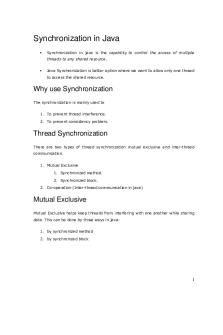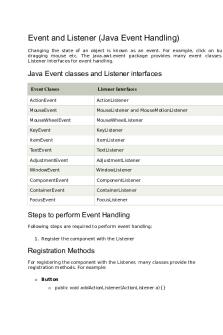Access Specifiers in Java PDF

| Title | Access Specifiers in Java |
|---|---|
| Author | Sakshi Bhalothia |
| Course | Java Programming |
| Institution | Banasthali Vidyapith |
| Pages | 4 |
| File Size | 111.5 KB |
| File Type | |
| Total Downloads | 9 |
| Total Views | 158 |
Summary
public, private etc....
Description
Access Specifiers in Java - Java Access Specifiers (also known as Visibility Specifiers ) regulate access to classes, fields and methods in Java.These Specifiers determine whether a field or method in a class, can be used or invoked by another method in another class or sub-class. Access Specifiers can be used to restrict access. Access Specifiers are an integral part of objectoriented programming. Types Of Access Specifiers : In java we have four Access Specifiers and they are listed below. 1. Public 2. Private 3. Protected 4. Default (no specifier)
Public specifiers : Public Specifiers achieves the highest level of accessibility. Classes, methods, and fields declared as public can be accessed from any class in the Java program, whether these classes are in the same package or in another package. Eg. public class Demo { // public class public x, y, size; // public instance variables public void find_fact(){}// public method }
Private specifiers : Private Specifiers achieves the lowest level of accessibility. private methods and fields can only be accessed within the same class to which the methods and fields belong. private methods and fields are not visible within subclasses and are not inherited by subclasses. So, the private access specifier is opposite to the public access specifier. Using Private Specifier we can achieve encapsulation and hide data from the outside world.
Eg private double x, y; // private (encapsulated) instance variables private void find_fact(){}// private method
protected specifiers : Methods and fields declared as protected can only be accessed by the subclasses in other package or any class within the package of the protected members' class. The protected access specifier cannot be applied to class and interfaces.
default(no specifier): When you don't set access specifier for the element, it will follow the default accessibility level. There is no default specifier keyword. Classes, variables, and methods can be default accessed.Using default specifier we can access class, method, or field which belongs to same package,but not from outside this package. Eg. class Demo { int i; (Default) }
//Accessible within the subclass outside the package package mypack; import java.util.Scanner; public class Person { int id; String name; protected void set_data() { Scanner scan=new Scanner(System.in); System.out.println("Enter the Id:"); id=scan.nextInt(); System.out.println("Enter the Name:"); name=scan.next(); } protected void display() { System.out.print(id+"\t"+name+"\t"); } };
import mypack.Person; import java.util.Scanner; class Test extends Person { int sal; public void set_data() { super.set_data(); Scanner scan=new Scanner(System.in); System.out.println("Enter the sal:"); sal=scan.nextInt(); } public void display() { super.display(); System.out.print(sal);
} public static void main(String args[]) { Test p=new Test (); p.set_data(); p.display(); } }...
Similar Free PDFs

Access Specifiers in Java
- 4 Pages

Loopsin Java - Loops in Java
- 9 Pages

Student Access IN Ufuture
- 22 Pages

Synchronization in Java
- 11 Pages

Multithreading in Java
- 12 Pages

Event Handling IN JAVA
- 6 Pages

Programmazione in Java Script
- 177 Pages

Access-Template - Access-Template
- 11 Pages

Klassen und Objekte in Java
- 5 Pages

Text Based Game in java
- 3 Pages

Design Patterns in Java Tutorial
- 168 Pages

Thinking in Java 4th edition
- 6 Pages

MCQs-java - Java Questions
- 15 Pages
Popular Institutions
- Tinajero National High School - Annex
- Politeknik Caltex Riau
- Yokohama City University
- SGT University
- University of Al-Qadisiyah
- Divine Word College of Vigan
- Techniek College Rotterdam
- Universidade de Santiago
- Universiti Teknologi MARA Cawangan Johor Kampus Pasir Gudang
- Poltekkes Kemenkes Yogyakarta
- Baguio City National High School
- Colegio san marcos
- preparatoria uno
- Centro de Bachillerato Tecnológico Industrial y de Servicios No. 107
- Dalian Maritime University
- Quang Trung Secondary School
- Colegio Tecnológico en Informática
- Corporación Regional de Educación Superior
- Grupo CEDVA
- Dar Al Uloom University
- Centro de Estudios Preuniversitarios de la Universidad Nacional de Ingeniería
- 上智大学
- Aakash International School, Nuna Majara
- San Felipe Neri Catholic School
- Kang Chiao International School - New Taipei City
- Misamis Occidental National High School
- Institución Educativa Escuela Normal Juan Ladrilleros
- Kolehiyo ng Pantukan
- Batanes State College
- Instituto Continental
- Sekolah Menengah Kejuruan Kesehatan Kaltara (Tarakan)
- Colegio de La Inmaculada Concepcion - Cebu


